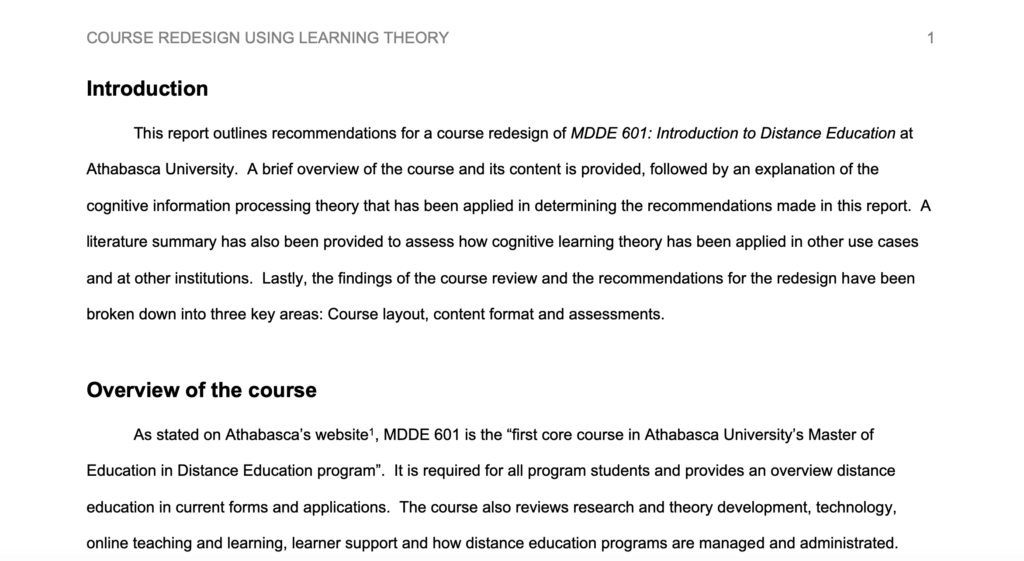Course Redesign
My first artefact is the first assignment from MDDE 603: Foundations of Instructional Design, the third course I took as part of my Masters program. There were two options for this assignment. Option A was to redesign an Athabasca University course, MDDE 601. Option B was to redesign a course of our choosing. The same assignment guidelines applied for both options. I chose Option A as I had recently taken MDDE 601 and it was still fresh in my mind, and I was able to easily draw on my reflections of the course.
Why this artefact?
Two of my initial learning goals were to learn more about instructional design and educational theory, so I knew I wanted to choose an artefact from this course to reflect on. There are other courses that I have taken that delve into educational theories, but this was the only one I took where instructional design was at the core of what I was learning. I was excited to do this assignment because of its practical application. From my understanding of course revision in my own workplace, I knew that providing recommendations on updates and revisions is a key piece at the beginning of a course revision. I knew that going through this process for the assignment would help in my understanding of the process and its importance in course revision.
This artefact demonstrates elements of the following MEd program competencies which are noted in parenthesis in my reflection:
- 2. Instructional Design & Development for Equity
- 2.2 Appropriately apply systems theory and systems analysis techniques to instructional design situations in distance education
- 2.8 Apply instructional design principles and models in open, digital, and distance education, in your workplace, or in other instructional contexts
- 4. Communication & Interpersonal Skills
- 4.1 Write clearly and in a style appropriate to purpose (e.g. assignments, reflective essays or journals, published documents, blog posts, eportfolios, and theses
- 4.3 Justify and defend your ideas orally and in writing in meetings, forums, seminars, exams and other contexts
- 5. Research
- 5.7 Summarize and synthesize information with a view to pursuing deeper understanding
Reflections on Artefact 1

When I started this assignment, I felt like I knew nothing about instructional design or educational learning theories. I was in over my head, but not in a bad way. I’ll admit I was both excited about taking this course, but also wishing I didn’t have to. I was excited because it was a challenge that I knew would become a valuable learning experience. Although I had worked in many areas of online and distance education, instructional design and the application of learning theories was a whole new sphere for me. Honestly, it was not something I was ever interested in learning more about. I wouldn’t call myself an academic, when I am in a discussion with colleagues and terms like ‘pedagogy’ are brought up, I tend to zone out. I don’t really know why, perhaps my brain isn’t wired that way. However, I knew that if I wanted to have a more well-rounded understanding of online and distance education, I would have to learn about the topic, but more importantly it’s application.
The assignment included providing a summary of the course as it was currently presented and what the learning goals were upon completion (4.1). I then had to choose a learning theory, either behavioral or cognitive, to support my recommendations for updates and revisions to the course (4.3). I chose cognitive information processing theory because of how it focuses on individual learning and how that it is impacted by environmental and sensory effects (2.2, 5.7). Because the course was meant to be done at a distance, cognitive theory best supported the design of the course as it was focused on the individual who had to, for the most part, learn on their own. The activities in the course should be designed so that they facilitate cognitive realism, where students feel that what they are learning is relevant and reflective for real world application. It was my understanding that cognitive realism can assist students with applying and retaining what they have learned. I think this is a key component of this master’s program, specifically the application of what is being learned. At a graduate level, and with many of us working full-time and balancing school and other commitments, it’s important that we are able to apply what we are learning, because our time is so limited.
Once I justified the use of cognitive theory for the design of the course, I then had to provide my findings and recommendations (2.8). For course layout, I pointed out that the current theme being used in the Moodle system resembled a term I have heard from colleagues as the “scroll of death”, where users have to scroll down the web page in order to find content, which can create a negative experience when navigating a course. I recommended applying a different format for the layout, as Moodle as many options from my use of it at our institution. A format that would allow for easy access, was more visually appealing and allowed for content to flow more seamlessly. Another recommendation I made had to do with the content, which was largely text and link-based that could be more appealing with some visual aids that would assist with knowledge retention. Lastly, I touched on the assessments in the course. I have found through many of the courses in this program that there are a lot of literature reviews. While it is important for graduate students to learn how to write a literature review, two in one course, along with including literature reviews in a substantial number of the courses, it can be easy for a student to lose interest and lack motivation because the assessment is not practical or applicable in a real-life context. As stated before, many of us who are in this program are also working full-time, so it would be more beneficial to have assessments that can be applied to real-word situations, like projects that can be used within our jobs or professional areas.
This assignment and this course were very applicable in helping to grow my understanding of instructional design and the importance of using learning theories. I always knew there was a reason, I just didn’t know what the reason was. Now, looking back on what I’ve learned and my experiences since taking the course, I know how critical instructional design is to creating and developing an online course. Especially during the pandemic. Back in March 2020, our institution had to quickly switch to completely online in a matter of days. Prior to this, many of our campus faculty did not see the benefit of our Open Learning division. When they had to switch, some literally overnight, to an online format where a majority of the course had to be designed in a way so the students could learn and understand it without in-person classes, there was a new appreciation for how much time and work was involved in creating an online course. Thankfully, our Instructional Designers and Moodle support team were there to offer their services and expertise, and provided a number of opportunities in the form of one-on-one sessions, workshops, virtual drop-in sessions to support our campus faculty do the quick switch. A lot of their work went unnoticed, but those of us who know all of the work that goes on behind the scenes hold a special appreciation for them in our hearts. In the past year and a half, we’ve hired some more of our campus faculty to deliver our ‘official’ online courses, and when they begin a training and orientation session with me, they comment on how they never fully realized how hard it is to create a course to be delivered online, or they are amazed at the fact that we have a whole division who creates, maintains and updates the content for them so they don’t have to do all of that leg work themselves. I’m sure many students at many institutions suffered through poorly designed online courses that were supposed to be online, and I’m sure that many instructors and faculty had an “awakening” as to what it means to design a course for successful learning, not just for an online format, but so that students can be successful in understanding and retaining what they are learning.
While I still do not feel like I fully understand instructional design and how all of the learning theories work and their applications, I still know more than I did. I feel like I have a better understanding of the purpose and importance of this key aspect in effectively delivering content online, and I know more about the whole process of course design – rather than just the bits and pieces that I knew about from my previous work experience.

Kate MacInnis
Excellent work Melissa! Your reflection is clear and well written, and the ties to your work life really add a practicability to the importance of this artefact. I also find the competencies you selected very appropriate and your reasoning for them is easy to understand. Fantastic job!
Melissa
Thank you for your feedback Kate! Greatly appreciated!
Susan Moisey
Melissa,
First a few nit-picky things:
a) first paragraph take should be taken.
b) You write, “This artefact demonstrates elements of competencies 2, 4 and 5” — these are competency areas. The actual competencies are things like 2.1, 4.2, etc.
It’s helpful for the reader if somewhere you can show what the competencies you identify are. Some students do this as a separate column. It could be done as a pop-up. Even if you provided the names f the competency areas would help in this regard.
I thought you provided an insightful analysis of the process and associated learning associated with this artefact. Nicely done.
Melissa
Hi Susan,
Thank you for your feedback and for catching the spelling error in the first paragraph! I’ve also provided more detail on the competencies and have included an additional page under my introduction section that lists the program competencies, which I will be providing a link to in each of my artefacts!
Heejeong Kim
Hi Melissa,
Great work on your introduction and artefact 1. I find your portfolio site very attractive, and your writing is clear and easy to read. I am looking forward to reading your following reflections. Keep up the excellent work.
Melissa
Thank you!